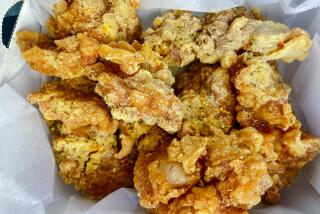In a Recession, Will New Fast-Food Chicken Chain Get Skinned Alive? : Franchises: Koo Koo Roo has plans to expand aggressively. But some experts say the timing couldn’t be worse.
Everyone knows the fast-food industry is in a pickle. Everyone knows fast-food customers would rather gorge on greasy burgers than--ugh!--skinless chicken. And everyone knows that with a McDonald’s on every corner, the last thing this country needs is another fast-food chain.
Everyone but Mike Badalian.
After traveling around the world to test chicken recipes, Badalian walked away from the glitter of Los Angeles’ gourmet restaurant scene four years ago to open a tiny charbroiled chicken restaurant with a name that sounds something like a rooster’s crow.
“All I know is, kids like the name Koo Koo Roo,” said Badalian, who admits that it is mostly parents--and not children--who go for his chain’s healthy menu. That could spell trouble. Analysts say it is often children--and not parents--who decide if the family eats at McDonald’s, Taco Bell or KFC.
What kid would pick chicken soaked in vegetable juices and a side order of--no joke here--warm pinto beans over Chicken McNuggets and fries? “Kids force their parents to go to McDonald’s,” Badalian said, “but it is parents who force their kids to go to Koo Koo Roo.”
That marketing quirk must be turned around quickly if the 15-store chain is to make any dent in the troubled fast-food industry. In fact, in a desperate attempt to attract more children, the chain is testing a skinless hot dog also made from, you guessed it, chicken.
Even if the chicken dogs don’t fly, big growth is in the offing. In 1992, the 4-year-old chain plans to open 27 new outlets--mostly in Southern California. A Southern franchiser may add 33 units within a few years. All of this in an industry that has seldom seen such bad times.
The ongoing recession has wreaked havoc on the fast-food business. Although it remains a $75-billion industry worldwide, fast-food experts generally believe that most future growth will take place outside the United States. Many Americans who have flooded fast-food chains for the last three decades now are recognizing that they can save money, eat healthier and be happy with home cooking.
On the West Coast, the trend-setting sector of the fast-food industry, the problem is particularly acute. Last year, there was a drop of about 5% in fast-food restaurant visits, and even the heaviest users have cut back their visits by about 25%, according to a recent study by the Brea-based consulting firm, Sandelman & Associates.
Some industry experts are even calling the Koo Koo Roo concept, well, cuckoo.
“Consumers talk a good story about how they care about health and nutrition,” said Robert L. Sandelman, president of Sandelman. “But when it gets right down to it, they’re much more likely to buy a greasy hamburger than an order of sprouts.”
Even if consumers were to go ga-ga over the chicken, the timing of the chain’s expansion plans could hardly be worse, points out David Rose, security analyst at the Irvine-based investment firm Cruttenden & Co. “In this climate, their growth strategy seems awfully aggressive.”
From a single Los Angeles location in 1988, the chain added one more in 1989, three in 1990 and a dozen last year. Much of the initial funding came from Kenneth Berg, the company chairman who plunked $2 million into the chain after stepping into a Koo Koo Roo and ordering a meal.
For future expansion, Koo Koo Roo raised $5 million in a public stock offering in October. Spector Corp., a fast-food franchise group, has agreed to open 33 Koo Koo Roo’s in Florida and Georgia over the next five years. After losing money its first three years, Badalian says the company will turn a profit in 1992.
The 57-year-old Badalian has spent the better part of four decades in the food-service business. In the mid-1980s, he co-owned one of the Southland’s most posh La Cienega eateries, Bistango, which was so popular at one time that it regularly had patrons waiting to get seated after midnight. The popularity quickly waned, however, and it closed within three years.
But Koo Koo Roo is no flash in the pan, Badalian says. It follows in the still-shaky footsteps of the nation’s largest charbroiled-chicken chain, El Pollo Loco, which has 205 outlets nationally. El Pollo Loco was sued last year by franchisees who complained that the chain had failed to live up to its ambitious growth goals. The suit is still in the courts.
“Our problem is we opened too many restaurants too quickly and too close together,” said James Verney, chief operating officer of Irvine-based El Pollo Loco. And that, he says, may soon become Koo Koo Roo’s problem too. “They’re going to have a hard time,” he said.
Although food critics have generally raved about the quality of Koo Koo Roo’s food, industry analysts say its relatively high prices may be its ultimate undoing.
While McDonald’s sells burgers for under a buck, and Taco Bell hawks tacos for less than 50 cents, a two-piece combination meal at Koo Koo Roo costs $3.95. Toss in a soft drink and it’s difficult to pay less than $5 for a meal. With pricey side dishes such as fruit salad at $2.25 and warm eggplant salad at $1.95, a sit-down lunch at Denny’s may be less expensive.
But Badalian insists that the real value isn’t price, but tasty food that’s also good for you. All of the food items on Koo Koo Roo’s menu--except for the french fries--have received the American Heart Assn. seal of approval. The chicken is fresh--cooked on skewers over flame broilers.
But Koo Koo Roo is still mostly unknown--even though it recently opened a high-profile unit in the Taj Mahal Hotel in Atlantic City. To become more familiar, it will soon start advertising on cable TV in Southern California. A Los Angeles agency is about to be selected.
Ronald McDonald needn’t worry, but look for some sort of animated rooster to soon be on TV crowing about Koo Koo Roo.
The chain’s boosters are crowing already. “The public is tired of the sameness in fast food,” said Barbara Dawson, West Coast editor for the trade publication Restaurants & Institutions. “I think they really have a chance to make it.”
So do some avid customers. “It’s the Kentucky Fried Chicken of the 1990s,” said Carol Leemon, administrator of the not-for-profit law firm Public Counsel, whose offices are near a Koo Koo Roo. She serves the chicken at her board meetings. “It’s a really L.A. thing.”
Koo Koo Roo Inc. at a Glance:
Koo Koo Roo Inc. was founded with a single unit in Los Angeles in August, 1988, as a fast-food chain specializing in charbroiled, skinless chicken. Its co-founders are two brothers, Mike and Ray Badalian. The firm’s chairman, Kenneth Berg, is the largest individual investor.
Growth was slow the first few years, but in 1991 it added a dozen new units, mostly in Southern California. There are currently 15 units--with a total of 42 stores expected by the end of 1992.
The firm raised $5 million for expansion through a public stock offering in October, 1991.
Future growth will be primarily through franchising, with plans for 33 new units in Florida and Georgia within the next five years.
The company’s first cable TV ad campaign is expected to break this month.
Koo Koo Roo, with headquarters at 3350 Wilshire Blvd., has nearly 80 employees.
More to Read
Inside the business of entertainment
The Wide Shot brings you news, analysis and insights on everything from streaming wars to production — and what it all means for the future.
You may occasionally receive promotional content from the Los Angeles Times.










